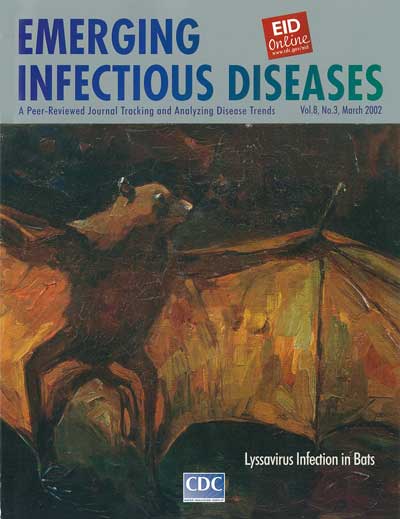ISSN: 1080-6059
Volume 8, Number 3 –March 2002
About the Cover
| Flying Fox |
Paul Arguin* ![]()
*Centers for Disease Control and Prevention, Atlanta, Georgia, USA
Suggested citation for this article

Flying Fox
Vincent van Gogh, 1885, oil on canvas, 41 cm x 79 cm, Courtesy of Van Gogh Museum, Amsterdam (Vincent van Gogh Foundation)
According to the Van Gogh Museum in Amsterdam, the origins of Flying Fox are not well documented. Van Gogh probably saw a flying fox in a museum or private collection in Brabant, Antwerp, or Paris. The dark brown background colors in the painting are similar to those in other works of his Nuenen period. The brighter colors and rough brushstrokes in the wings are more avant garde and suggest techniques used in his later paintings.
Flying foxes like the one that captured van Gogh’s imagination are very large fruit-eating bats (order Chiroptera, suborder Megachiroptera). These mammals are found in tropical and subtropical regions between Africa and the South Pacific, including the Philippines, where there are 70 species of bats. Flying foxes can weigh as much as 1.5 kg and have a wingspan of up to 1.8 m. Occasionally, they are hunted and used as a food source (1).
Worldwide, bats are a major predator of night-flying insects and farm pests. Throughout the tropics, they are vital to the survival of the rain forest through their seed dispersal and pollination activities. Studies of bats have contributed to medical advances, including the development of navigational aids for the blind.
References
Nowak RM. Walker’s bats of the world. Baltimore: The Johns Hopkins University Press; 1994
Suggested Citation for this Article
Arguin P. Flying Fox [about the cover]. Emerg Infect Dis [serial on the Internet]. 2002 Mar [date cited]. Available from: http://www.cdc.gov/ncidod/EID/vol8no3/cover.htm
Please use the form below to submit correspondence to the following address:
Polyxeni Potter, EID Journal, Centers for Disease Control and Prevention, 1600 Clifton Rd, Mailstop D61, Atlanta, GA 30333, USA; email: PMP1@cdc.gov
Please contact the EID Editors at eideditor@cdc.gov
The opinions expressed by authors contributing to this journal do not necessarily reflect the opinions of the U.S. Department of Health and Human Services, the Public Health Service, the Centers for Disease Control and Prevention, or the authors' affiliated institutions. Use of trade names is for identification only and does not imply endorsement by any of the groups named above.
This page posted March 28, 2002
Centers for Disease Control and Prevention, 1600 Clifton Rd, Atlanta, GA 30333, U.S.A
Tel: (404) 639-3311 / Public Inquiries: (404) 639-3534 / (800) 311-3435